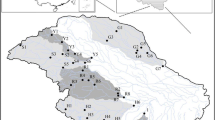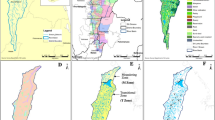Abstract
Changes in the hydrologic characters of the Tarim River Basin of Xinjiang Province during the past 50 years were studied to identify the key factors responsible for these changes. Observed hydrologic and socio-economic data provided the basis for this study. The impact of human activities on the decrease in the streamflow and changes in total dissolved solids (TDS) in the watercourse and groundwater of the mainstream were analyzed using the Mann–Kendall test, regression and principal component analysis. The results showed that during the past 50 years the streamflow in the headwater streams has increased slightly while the streamflow in the mainstream has decreased significantly. Human activities along the mainstream are the primary reason for the decreased streamflow, with the impact of human activities on the decrease in the streamflow of the mainstream being 65.61, 74.73 and 77.62% in the 1970s, 1980s and 1990s, respectively. The key factor that affected the TDS of the watercourse was the decreasing streamflow, which was caused by anthropological activities. However, the TDS of the groundwater was found to be affected significantly by groundwater depth. The degeneration of ecosystems in the lower reaches of the Tarim River was directly related with anthropogenic activities.












Similar content being viewed by others
References
Chen YN, Xu ZX (2005) Plausible impact of global climate change on water resources in the Tarim River Basin. Sci China Ser D Earth Sci 48:65–73
Chen YN, Zhang XL, Cui WC (2003) Ecological problems and proposals in Tarim River Basin, Xinjiang. Bull Chin Acad Sci 3:191–195
Chen YN, Zilliacus H, Li WH, Zhang HF, Chen YP (2006) Groundwater level affects plant species diversity along the lower reaches of the Tarim River, Western China. J Arid Environ 66:231–146
Fan ZL, Xia XC, Shen YL, Kurban A, Wang RH, Li SY, Ma YJ (2002) Utilization of water resources, ecological balance and land desertification in the Tarim Basin, Xinjiang. Sci China Ser D 45:102–108
Gao QZ, Chu YQ (2004) Analysis of water cycle in inland river basins in Hexi region. Adv Water Sci 15:391–396
Gong L , Pan XL, Shi QD, Wang ZM, Gao W (2005) Land use pattern and influential factors in the upper reaches of Tarim River. Resour Sci 27:71–75
Hou P, Beeton RJS, Carter RW, Dong XG, Li X (2007) Response to environmental flows in the Lower Tarim River, Xinjiang, China: an ecological interpretation of water-table dynamics. J Environ Manage 83:383–391
Huntington TG (2006) Evidence for intensification of the global water cycle: review and synthesis. J Hydrol 319:83–95
Kadiolgu M (1997) Trends in surface air temperature data over Turkey. J Climatol 17:511–520
Kahya E, Kalayci S (2004) Trend analysis of streamflow in Turkey. J Hydrol 289:128–144
Li XY, Luo Y, Wang LX (2003) Study on the disturbance of human activities on the hydrological process in Tarim River watershed. J Zhengzhou Univ Eng Sci 24:93–98
Lioubimtseva E, Cole R, Adams JM, Kapustin G (2005) Impacts of climate and land-cover changes in arid lands of central Asia. J Arid Environ 62:285–308
Liu D, Liu SQ, Xu ZM (1997) Environmental isotope studies on shallow groundwater in the lower Tarim River, Xinjiang. J Chengdu Univ Technol 24:89–95
Meir P, Cox P, Grace J (2006) The influence of terrestrial ecosystems on climate. Trends Ecol Evol 21:254–260
Messerli B, Grosjean M, Hofer T, Nunez L, Pfister C (2000) From nature- dominated to human-dominated environmental changes. Quaternary Sci Rev 19:459–479
Nyssen J, Poesen J, Moeyersons J, Deckers J, Haile M, Lang A (2004) Human impact on the environment in the Ethiopian and Eritrean highlands—a state of the art. Earth Sci Rev 64:273–320
Ren LL, Wang MR, Li CH, Zhang W (2002) Impacts of human activity on river runoff in the northern area of China. J Hydrol 261:204–217
Saiko TA, Zonn IS (2000) Irrigation expansion and dynamics of desertification in the circum-Aral region of central Asia. Appl Geogr 20:349–367
Serreze MC, Walsh JE, Chapin FS, Osterkamp T, Dyurgerov M, Romanovsky V, Oechel WC, Morison J, Zhang T, Barry RG (2000) Observational evidence of recent change in the Northern high-latitude environment. Clim Change 46:159–207
Sharma TC (1985) Stochastic models applied to Evaluating hydrologic changes. J Hydrol 78:61–81
Smadi MM, Zghoul A (2006) A sudden change in rainfall characteristics in Amman, Jordan during the mid 1950s. Am J Environ Sci 2:84–91
Sneyers R (1990) On the statistical analysis of series of observation. WMO Technical Note No.143. Secretariat of the WMO, Geneva, Switzerland
Wang SD, Wang YG, Wang J, Mao WY, Shen YP (2003) Change of climate and hydrology in the Tarim River Basin during past 40 years and their impact. J Glaciol Geocyrol 25:315–320
Xu CY (2000) Modeling the effects of climate change on water resources in central Sweden. Water Resour Manage 14:177–189
Xu CC, Chen YN, Li WH, Chen YP (2006) Climate change and hydrologic process response in the Tarim River Basin over the past 50 years. Chin Sci Bull 51[Suppl 1]:25–36
Yu YS, Zou S, Whittmore D (1993) Nonparametric trend analysis of water quality data of rivers in Kansas. J Hydrol 150:61–80
Zhang H, Wu JW, Zheng QH, Yu YJ (2003) A preliminary study of oasis evolution in the Tarim Basin, Xinjiang, China. J Arid Environ 55:545–553
Zhang YK, Schilling KE (2006) Increasing streamflow and baseflow in Mississippi River since the 1940s: effect of land use change. J Hydrol 324:412–422
Zheng YR, Xie ZX, Robert C, Jiang LH, Shimizu H (2006) Did climate drive ecosystem change and induce desertification in Otinday sandy land, China over the past 40 years? J Arid Environ 64:523–541
Acknowledgments
This work is financially supported by the “Innovative Program of The Chinese Academy of Sciences (Grant No: kzcx2-yw-127)”, “The West Project Foundation of Chinese Academy of Sciences (Grant No: KZCX2-XB2-03)” and “National Natural Science Foundation of China (Grant No: 90502004, 30500081)”. Special thanks are given to editors and anonymous reviewers whose comments helped to improve the paper.
Author information
Authors and Affiliations
Corresponding author
Rights and permissions
About this article
Cite this article
Hao, Xm., Chen, Yn. & Li, Wh. Impact of anthropogenic activities on the hydrologic characters of the mainstream of the Tarim River in Xinjiang during the past 50 years. Environ Geol 57, 435–445 (2009). https://doi.org/10.1007/s00254-008-1314-0
Received:
Accepted:
Published:
Issue Date:
DOI: https://doi.org/10.1007/s00254-008-1314-0




